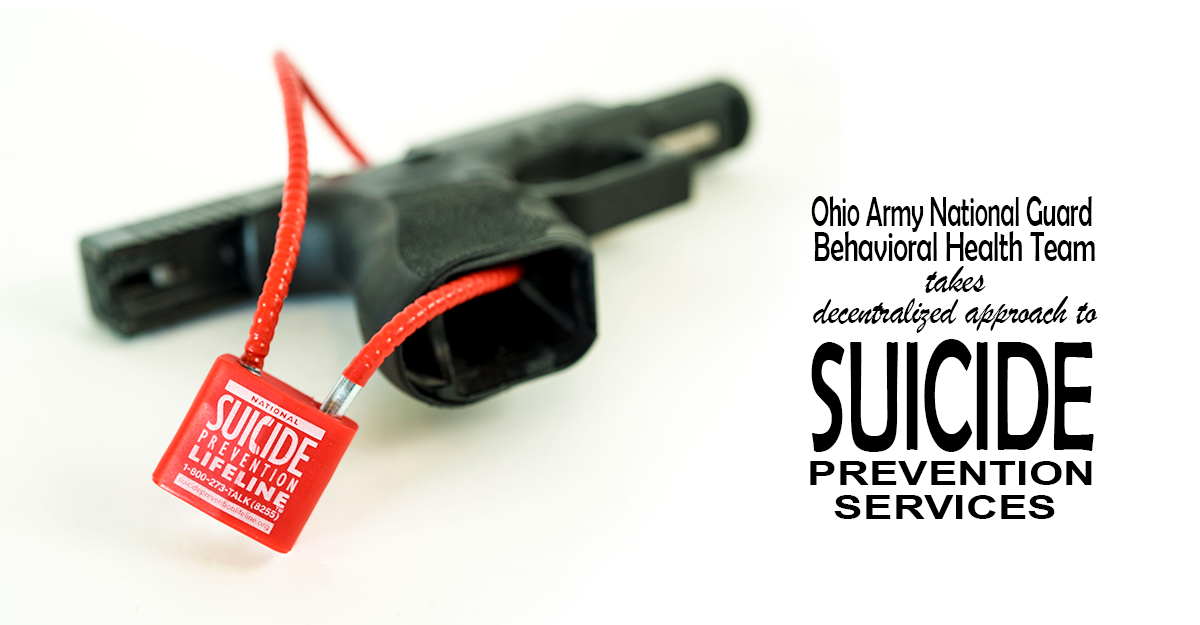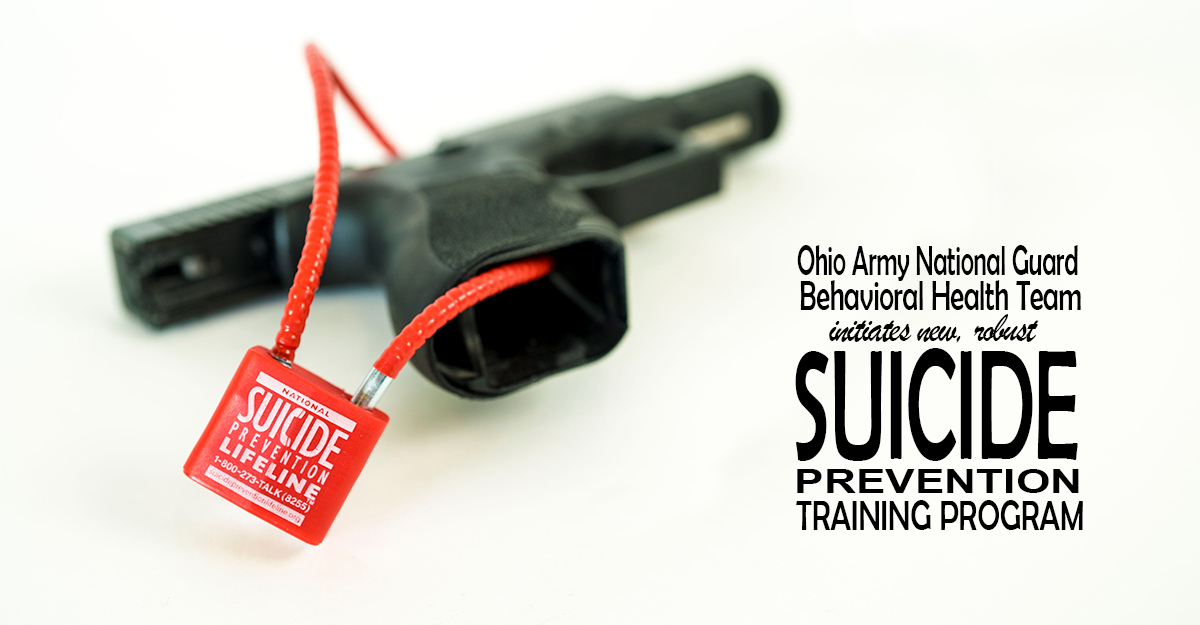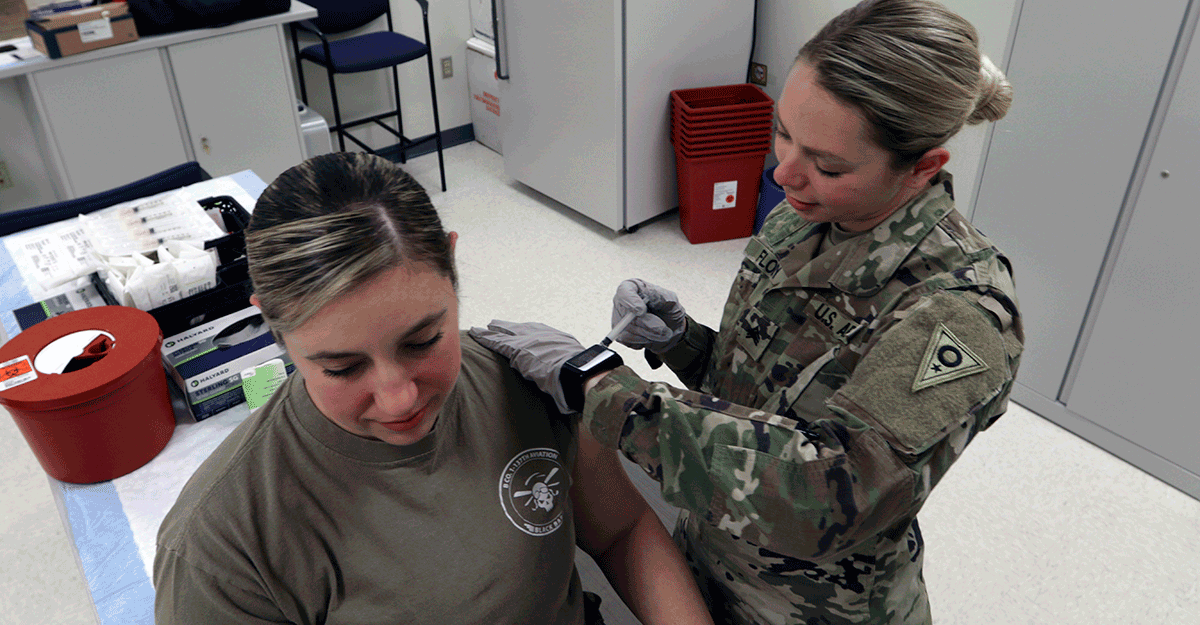September is Suicide Prevention Month
Ohio Army National Guard Behavioral Health Team takes decentralized approach to suicide prevention services
Story by Sgt. 1st Class Chad Menegay, Ohio National Guard Public Affairs
COLUMBUS, Ohio (09/29/20)
The Department of Defense’s Annual Suicide Report released in September 2019 stated that the National Guard has the highest suicide rate of all military components. The figure can be argued to be relatively small — at less than one-tenth of 1%. However, at 30.6 suicide deaths per 100,000 Guard members, one suicide is too many. The suicide rate is higher than for the National Guard’s active duty and reserve counterparts and also significantly higher than the general U.S. population of 18.2 per 100,000 people for ages 17-59.
In the second in a series on suicide prevention, we explore who is working to solve the National Guard’s suicide problem, and where have we responded to that problem successfully.
The Ohio Army National Guard Behavioral Health Team has expanded its suicide prevention efforts by anchoring its roots in research and enriching its complex conducting tissue as conjoined extensions of the National Guard Bureau’s decentralized approach. That is to say the Ohio team has jointured with a great number of institutions and organizations that also seek to prevent suicides.
National Guard Bureau encourages such grassroots activities and empowers its state-level teams to lean their photoreceptors toward light within their reach, to study suicide prevention locally and focus on issues unique to regions and cultures within each state.
One project is the Veteran Center Outreach Initiative, a Department of Veterans Affairs program that lets Guard members living in remote locations have access to behavioral health care. The DOD and the VA also formed a partnership that provides behavioral health services to Guard members during annual training and drill weekends.
“Some of our service members who have homes in rural Ohio have to drive two hours to see a behavioral health person,” said Madelyn Scarberry, a psychological health coordinator for the Ohio Army National Guard (OHARNG) Behavioral Health Team (BHT). “Access is a huge issue. The VA is looking to do more with telehealth, and that’s something we would like to explore.”
Army Guard members, as Citizen-Soldiers, often don’t have the same access to the kinds of services that an active-duty service member would. Partnerships and making resources more readily available are key to supporting these people.
“A decentralized approach is important because there are many things that happen far before a person is on the ledge contemplating suicide,” said Colin Fowler, another psychological health coordinator for the OHARNG BHT. “And the factors that lead to suicide are multifaceted: relationships, feeling connected, financial issues, drugs and alcohol, sleep, general health care.”
The DOD’s Suicide Prevention Month 2020 theme is “Connect to Protect,” which points to the important role connections play in preventing suicide, whether they be connections to family, friends, coworkers, community members, or whether they be connections to information, resources, treatments, counselors and other support systems.
The OHARNG BHT has many of these connections pre-established and can use those connections to get Soldiers on a path to improved mental health.
There might be too many organizations, institutions and programs to name, but internally, for example, the BHT consults with ARNG leaders on issues of behavioral health and consults with case management regarding individuals who have behavioral health issues, connecting them with resources. They work with the Family Readiness and Warrior Support Program, the DOD Yellow Ribbon Reintegration Program, chaplains and other health and welfare programs. Then, externally, there’s a great deal of collaboration with other offices and organizations in the community. They attend events such as fairs and participate in meetings at the Statehouse.
“We conduct trainings and briefings; we coordinate events,” said Gloria Stewart, the OHARNG Suicide Prevention Program manager, adding that she encourages Guard members to seek help and not see asking for help as a weakness. “It’s just having compassion for yourself,” she said. “I speak life-giving words to make them feel engaged, so they don’t feel excluded, and they seek help.”
There are many avenues by which Guard members can seek that help and many resources the BHT can point to according to individual needs, including:
- The BHT is invested in and coordinates with leaders of the Army’s resilience training program and Applied Suicide Intervention Skills Training (ASIST).
- They work with the Red Cross to train Soldiers in mind and body connections, as in mindfulness meditation and deep breathing.
- They are in step with OHIOcares, whose purpose is to enhance the “safety net” of behavioral health services available for military personnel and their families including the services available through the VA and Vet Centers.
- BHT also works with the Ohio Suicide Prevention Foundation, an Ohio 501c3 not-for-profit organization that works to bring about changes in attitudes and perceptions surrounding suicide and its relationship to mental illness, alcohol and drug abuse.
- They are a major partner in the Serving Ohio Guardsmen and Women (SOG) Project, a three-year campaign which seeks to empower Ohio’s military, their families, and those serving them to take ownership of their mental health, engage in positive mental health strategies, and be aware of the resources available in Ohio to support them in times of need.
- They partner with Mental Health First Aid (MHFA), a full-day training that provides education on mental health, skills to recognize peer distress, and confidence to provide support and refer individuals to mental health services when needed.
All the above mentioned work and many other initiatives are part of a comprehensive DOD public health approach to suicide prevention, because research has proven that suicide results from a complex interaction of many factors — environmental, psychological, biological and social. There is no one solution.
“Suicide prevention is a collaborative and integrated approach involving multiple departments, lots of people throughout the state and multi community agencies, a network of resources and sharing,” Scarberry said.


